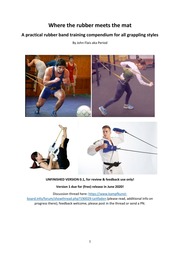Period
Level 6 Valued Member
Hi, as some of you know, I have been working on a guide to rubber / resistance band training for grapplers; it may be of some interest for non-grapplers as well, but it's really aimed at the grappling crowd. It's been over two years in the pipeline, and lately I didn't really get around to work on it much for work reasons, nor did I get much new input, so I decided to just upload it in its semi-finished stage - please don't expect graphical perfection or professional editing.
The book contains a bit of history on rubber band training in grappling, my attempts at describing how they are typically used in the grappling schools I am familiar with, an overview on types of bands you can use (from home depot to the top brands), and a bunch of links to youtube videos with my comments.
You can find my profile at the end of the book if you're interested, so I will keep that brief here: I'm a former Freestyle and Greco wrestler in what would be the exquivalent of D1 over here in Europe, and have trained (sometimes even coached) a number of grappling styles. My coaches and teammates were mostly Russians, they have gotten me hooked on long (3-5m) bands. We consider them the single most important training tool for grappling after partner and mat work, everything else is optional. They are well known and widely used in the former Eastern block as well as the Judo powerhouses (especially South Korea), but good information is not easy to find in the West; I have tried my best to collect and present what I was able to.
It's an entirely non-commercial project that I did for fun, so there are zero strings attached (in fact, I don't have a website, don't sell anything and only coach people I personally know for free). Therefore, I am using Archive as a platform again, where I already published my first (German) book eight years ago.
Here's the link:

All feedback - the good, the bad and the ugly - is welcome. Have fun.
Cheers
Period.
The book contains a bit of history on rubber band training in grappling, my attempts at describing how they are typically used in the grappling schools I am familiar with, an overview on types of bands you can use (from home depot to the top brands), and a bunch of links to youtube videos with my comments.
You can find my profile at the end of the book if you're interested, so I will keep that brief here: I'm a former Freestyle and Greco wrestler in what would be the exquivalent of D1 over here in Europe, and have trained (sometimes even coached) a number of grappling styles. My coaches and teammates were mostly Russians, they have gotten me hooked on long (3-5m) bands. We consider them the single most important training tool for grappling after partner and mat work, everything else is optional. They are well known and widely used in the former Eastern block as well as the Judo powerhouses (especially South Korea), but good information is not easy to find in the West; I have tried my best to collect and present what I was able to.
It's an entirely non-commercial project that I did for fun, so there are zero strings attached (in fact, I don't have a website, don't sell anything and only coach people I personally know for free). Therefore, I am using Archive as a platform again, where I already published my first (German) book eight years ago.
Here's the link:
John Flais Where The Rubber Hits The Mat Protoversion 1 : John Flais : Free Download, Borrow, and Streaming : Internet Archive
A guide to using rubber bands as a training aid for all grappling styles (freestyle, folkstyle and Greco-Roman wrestling, Catch wrestling, Sambo, Judo, BJJ,...
archive.org
All feedback - the good, the bad and the ugly - is welcome. Have fun.
Cheers
Period.
